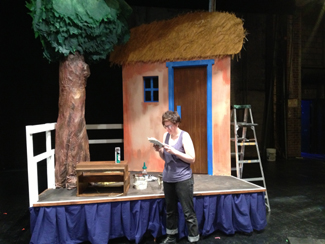Carolyn Mraz is a New York-based set designer of theater and live performance. Interested in the aesthetic development of experimental works, she often collaborates on world premieres of devised pieces, new plays, and radical reconstructions of classics.Credits include: SPACEMAN (Incubator Arts at St. Mark’s Church), Barking Girl (East 4th St. Theater), A History of Launching Ships (Polybe & Seats at BLDG 92 Brooklyn Navy Yard), Life is Happening to Us Again (A Host of People), Acquainted With The Night (Rachel Chavkin, director), Once In A Lifetime (Emma Griffin, director), The Puppet Show (TMT Lab at The Bushwick Starr), ThisisitIsthisit [ ]: A Map Of The Known World (The Bushwick Starr). Carolyn is a proud associated artist of Target Margin Theater. MFA in design from NYU Tisch.
TMT: We’re all students and teachers when it comes to Yiddish at TMT. Before you started working on The (*) Inn what was your exposure to Yiddish theater/culture? I’ll go first, mine was Barbara in Yentl.
CM: I had little to no exposure to Yiddish theater before working on this with TMT, but I did find such a wealth of research photographs of historic Yiddish productions in NYC and abroad that really grabbed my interest.
TMT: The (*) Inn takes place in a Jewish community in Europe in the early 1900s and the design, from the painted drops to the handmade DIY barnyard animal cutouts, is an integral part of the artifice of reality we see on stage. How would you describe the design for The (*) Inn?
CM:The design for The (*) Inn sort of follows a trajectory of theater design history over the last 140 or so years. We begin in a representational farmhouse and landscape, change to a cubist/abstract farmhouse interior, then a dark, moody, and expressionistic Act 3, and finally, we end in a collage-type scene with the open stage and a combination of real items and fake props. The styles of the scenes vary wildly, but the changes follow the action of the play. As the story becomes weirder, as the characters become confused and question their perception of the reality, the scenery breaks from the established and confined pastoral day-to-day happenings on the farm to a larger, more unidentifiable open space with mixed artifice and real objects.
TMT: What would you say are the most challenging aspects of this production, both in terms of design and in terms of the play itself?
CM: Well, a 4 act play in 90 minutes with no intermission is a challenge in its own right! But everyone in front of and behind the scenes has been great about making it work so smoothly. The challenge with the script itself is that it sets you up to expect one kind of play–a straightforward comedy/drama about a wedding love triangle of a daughter—but then the play forks into these questions about spirits, and the merchants, and are characters possibly losing their minds—and the play never really answers any of these questions! So the last scene is this really strange, open-ended, and potentially confusing ending. Our production embraces the confusion inherent in the script by leaving all these questions unanswered–which, in turn, makes for a pretty challenging production. This production does not end by tying everything up in a neat little bow–and that is one of its biggest strengths.
TMT: You’ve worked with Target Margin many times in the past; you’re an affiliated artist and also lead artist of last year’s The Puppet Show in the Russian Futurist lab. You also recently came back from a trip in Detroit working with TMT affiliates Sherrine Azab & Jake Hooker. What else is cooking in your crock pot? Literally and theatrically?
CM: I’m working on the new play queerSpawn, by TMT associated artist Mallery Avidon, which goes up at HERE in May, a Romeo and Juliet performed by a group of 50 4th, 5th, and 6th graders in Hunts Point (as a project of The Shakespeare Society), and a version of The Diary of Anne Frank at my alma mater Oberlin College this summer. I am also looking forward to warmer and drier bicycling weather, and finally building some new storage shelves in my apartment.
TMT: Finally we ask you a question which has no wrong answer: “What is Yiddish Theater to you?”
CM: Yiddish theater to me—it’s just theater that was made by and for a specific community. It is fascinating to find–as Target Margin always seems to dig up—that truly weird and experimental plays have existed forever, and across many languages and cultures–and Yiddish in the 1920s is no exception!
TMT: Thanks Carolyn. Don’t forget to invite me over for more lentil soup!
